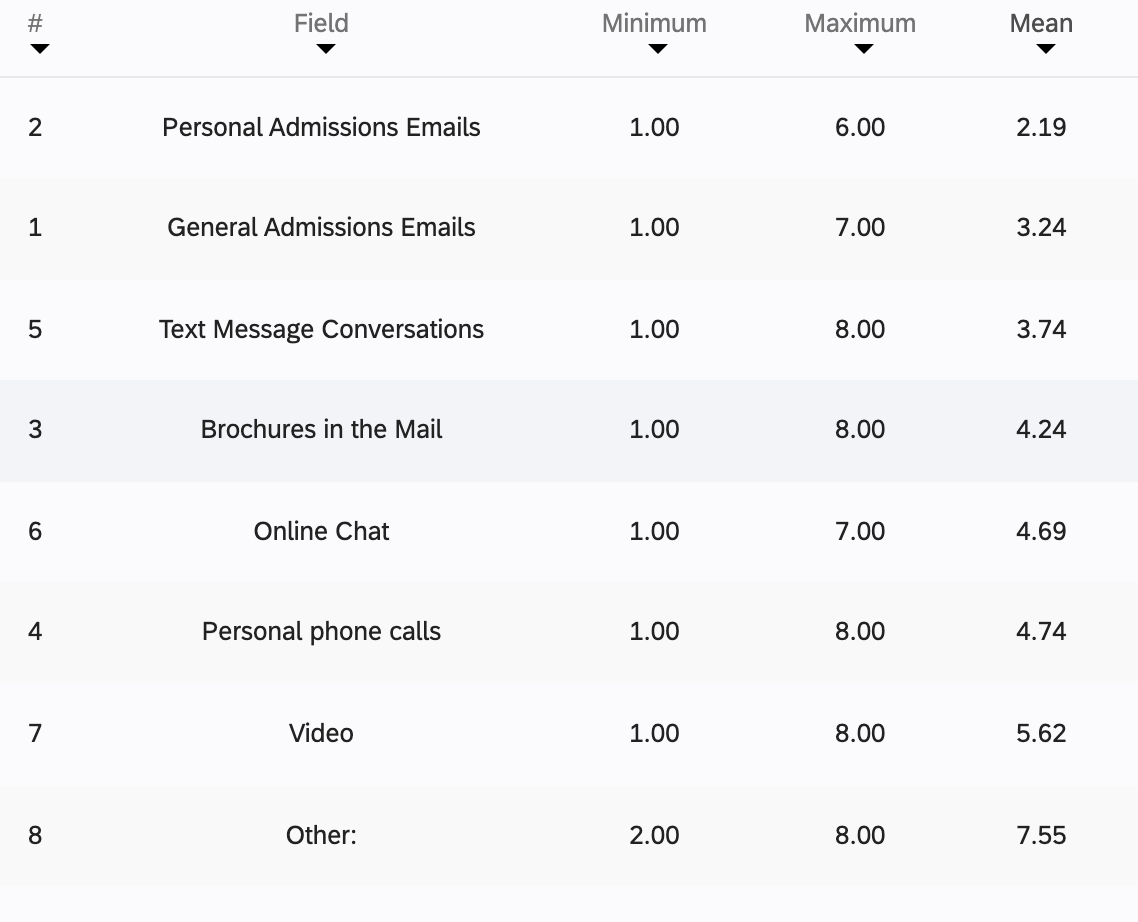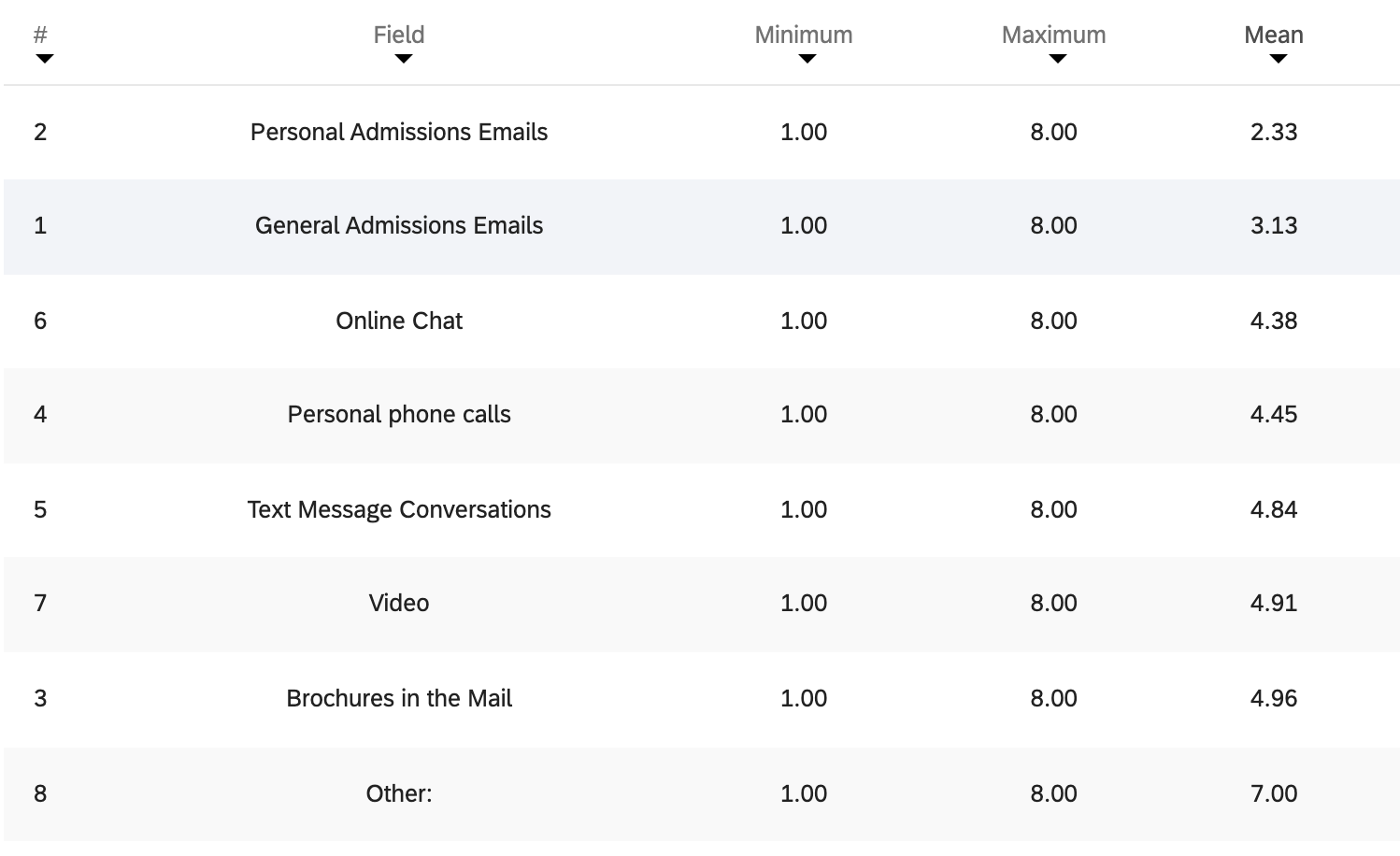5 Email marketing optimization musts for Higher Education enrollment managers.
Capturing a lead from your website, student fair, high school visit, or purchased prospect list is a crucial first step, but delivering an incredible brand experience for the following months (and sometimes years) leading up to application and enrollment is where so much of the work gets done.
We asked both graduate and undergraduate students what type of communication was most helpful / impactful to them, and this is what they told us: (Scale was 1-10, with 1 being the most helpful and impactful)
Undergraduate admissions communication preferences

Graduate admissions communication preferences

In both audiences, personal emails from admissions staff had the highest average ranking for being the most impactful and helpful communication channel.
No matter what additional tools you choose to use, having compelling and well-crafted emails should form the backbone of your nurture strategy.
1. Personalize emails with mail merge.
The foundation of strong emails is personalization. By addressing an email recipient by name you take advantage of an opportunity to grab their attention and make them feel important, ultimately encouraging them to engage in the conversation (Source: Using a Person’s Name in Conversation.)
Data and mail merge make it possible to reap the benefits of personalization in a scalable way. Mail merge utilizes data organized in a spreadsheet to repeatedly populate another document.
Too many enrollment pros, however, think that their mail merge systems can only personalize the name in an email’s salutation. Mail merge can allow you to personalize all sorts of content for a student so that your email message delivers highly relevant information to each student in one “blast”.
Imagine a scenario where you have a list of 2,000 students to send a message to. Let’s say that 500 people on that list have expressed interest in studying biology, 500 expressed interest in business, 500 expressed interest in Music, and 500 had expressed interest in Computer Science. You could:
- Draft a separate email for each area of study,
- Say “that’s too much work” and just send one generic message to everyone
- Leverage the power of mail merge to still send 1 message that ALSO personalizes content based on the student’s area of interest.
Instead of addressing it to “future student”, you can tell that document to pull data from an already populated excel sheet with the names and contact information of every person, and instead of saying “we have many majors to choose from”, you can dynamically insert a paragraph with specific information and next steps for their area of interest.
This process can be done with a word document and excel sheet by following a few simple steps. CRM’s like Slate also make this easy with built-in tools.
2. Improve readability with bullet points.
Readability is increased when your content is concise and succinct (Source: The Readable Blog.) Bullet points are designed to be just that. Utilizing bullet points in the body of your email improves your readers' experience in a few ways.
- You can highlight what is most important.
- They break up paragraphs.
- Bullets create white space which makes the content digestible.
- They’re fun to read.
While the often-cited shortening attention span of adults is probably not actually 8 seconds, we do know that people are inundated with written content and can be easily distracted by the next message in their inbox. Bullet points are a way to grab your reader's attention during that cursory few-second scan.
![]()
3. Send relevant content.
Every student who applies to and attends your school comes from a different background, has a wide range of interests, and ultimately will choose from many majors and fields of study. It makes sense that a one-size-fits-all approach to your email content will likely fall short.
Utilizing data and mail merge can make it easier to send relevant content. You can draft emails targeting undergraduate students versus graduates, or those interested in STEM fields versus those interested in fine arts. An email highlighting financial aid options could be sent to students who have identified cost as a barrier to applying.
Sending relevant content makes your audience feel heard and important. People pay attention to and lean into communication that aligns with their beliefs.
4. Optimize calls-to-action around student goals.
If your diligently crafted personalized emails are punctuated with generic CTA’s asking the student to “contact us” or simply “apply here” you are missing an opportunity to connect with prospective students in a more meaningful way. Instead, focus on what the students’ personal next steps would realistically be.
They may not be ready to “apply here” but they may be ready to learn about financial aid options here (or better still Find out what scholarships you may qualify for). Maybe they have already clicked “Contact us” on three other university pages with no response. Instead, they want to see the schedule for upcoming informational meetings. Think about what resources prospective students need next and leverage those as your CTA’s.

5. Interactive content > Paragraph Text.
Creating email content that your audience interacts with can capture their interest. Can they put their cursor over an image of the dining hall and see that day’s menu? How about rolling over an image of the biology building to see the inside of a lab or classroom?
You could even present your CTA’s as an interactive quiz. Instead of offering them a click here to see xyz, create a Smart Form that leads them to their personal CTA. This could look like I want to learn about… then provide 2-4 answers that link them to those resources… for example Financial Aid, Majors, and Minors, Residential Life.
This choose-your-own-adventure version allows them to pick the CTA most relevant to them in a fun and interactive way. It is customized while also allowing you to cast a wider net.
By embedding your CTA’s into an interactive feature, you can present them in the form of buttons rather than links which can increase conversion rates by as much as 28% according to Campaign Monitor.
Interactive content also allows you to include a denser amount of information without weighing down your email with lots of paragraphs and text.
Don’t over-optimize.
Customizing emails does not have to be complicated to be impactful. Utilizing data and Mail Merge can help you draft tailored emails to large groups while addressing each recipient as an individual. This keeps your emails relevant and targeted.
By using bullet points and interactive content you can call attention to points you want to highlight and include more content without loading your emails up with long prose.
Find a focus for your CTA’s that meets your students where they are in the process. Use your CTA’s as a guide of where to go as a next step rather than an end goal they might not be ready for.

